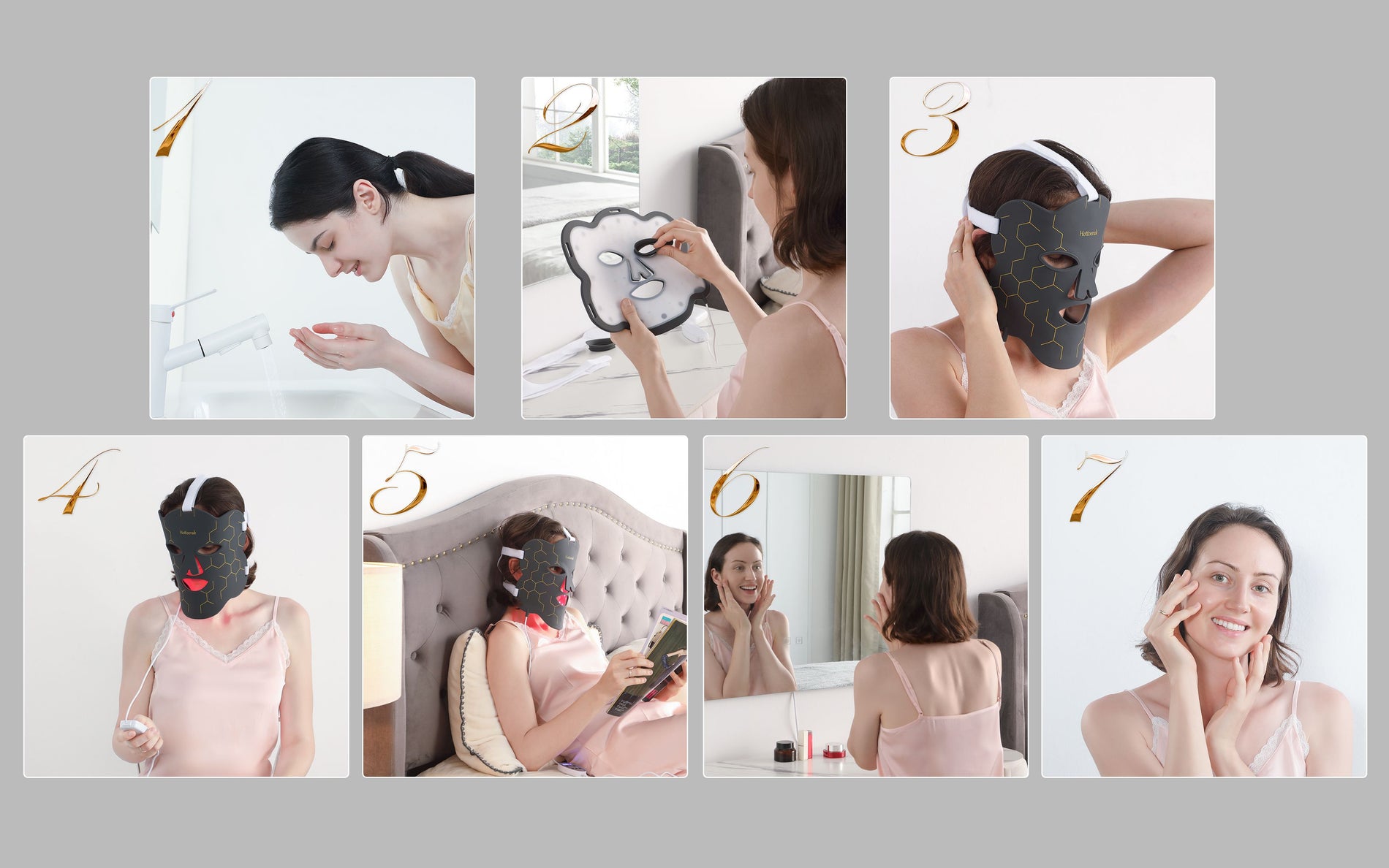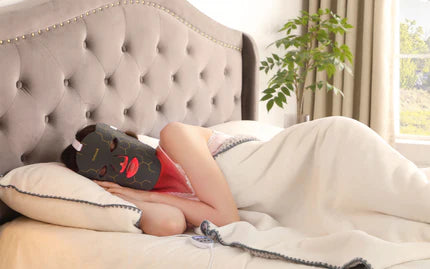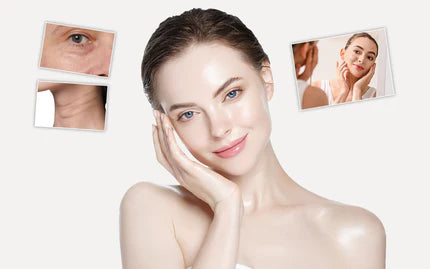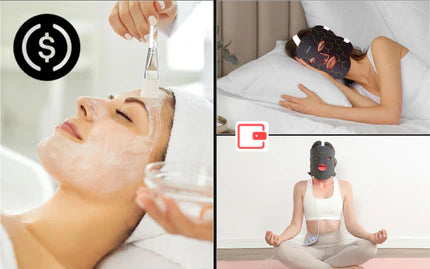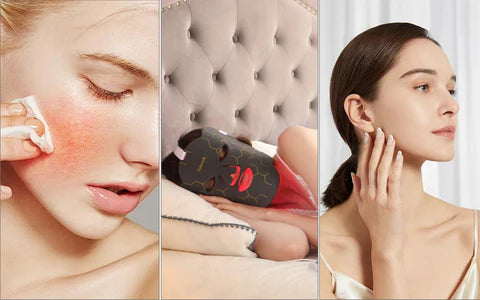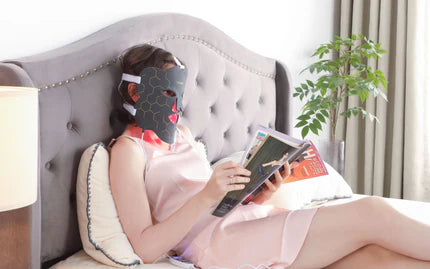Looking for a simple way to boost your skin's health? Red light therapy masks might just be what you need. They're catching on as a no-fuss solution to help reduce wrinkles, clear up acne, and even out skin tones with just the flip of a switch. In this guide, we'll explain how these masks work wonders on your skin, how to choose the best one for your face, and tips for using them effectively. Whether you're a skincare pro or someone who's just curious about improving their complexion, we've got you covered with all the details to get you started on the path to clearer, healthier-looking skin.

What Are the Basics of Red Light Therapy for Skin Care?
What Is Red Light Therapy Anyway?
Imagine giving your skin a cozy, beneficial light bath that can help refresh and heal it. That's red light therapy for you. It's a type of treatment that beams low-level red wavelengths right into your skin. But don't worry-it's not like a sci-fi laser zapping away; it's gentle and painless. At the cellular level, this red light dives deep, where it nudges your cells to get busy and do their jobs better. Think of it as a pep talk for your skin cells, encouraging them to regenerate and repair.
Skin SOS: What Can Red Light Therapy Fix?
If your skin had a wishlist, red light therapy would check off quite a few boxes. For starters, it's great for those battling acne; the light helps calm down inflammation and makes those angry red pimples less so. Then there's the anti-aging brigade. Red light therapy is like turning back the clock a bit, reducing those pesky fine lines by plumping up your skin with new collagen. And if you've got dark spots or uneven skin tone (hello, sun lovers!), red light can help even things out for a smoother look.
The Perks of Going Red
Let's talk about some solid perks of red light therapy-backed by science, not just hearsay. When you treat your skin to regular sessions, you're basically boosting your skin's collagen factory, which means firmer, tighter skin. Inflammation doesn't stand much of a chance either, so conditions like rosacea could also see some relief. Plus, it's all about healing and recovery; whether it's acne scars or just general skin damage, red light therapy promotes faster healing, leaving you with healthier, happier skin.
Finding Your Match: Picking the Right Red Light Therapy Mask
The Must-Haves in a Red Light Therapy Mask
Shopping for a red light therapy mask can feel like you're in a high-tech beauty bazaar. To get the real deal, keep your eyes peeled for a few key features. First up, wavelength range is king-look for masks that offer wavelengths between 600-850 nanometers, as that's the sweet spot for skin benefits. Also, check if the mask has FDA clearance, which means it's been given the green light for safety and effectiveness.
Personalizing Your Pick: Masks for Your Skin's Mood
Your skin is as unique as you are, and so are its needs. If breakouts are your main gripe, go for a mask that combines red with blue light-the latter is ace at zapping bacteria causing acne. For fine lines or sun damage, lean towards masks with a good dose of red light. Some masks come with settings to adjust intensity, so you can customize your treatment according to what your skin is craving at the moment.
Smart Shopping: Sifting Through the Options
Start by narrowing down options with the right features (remember the wavelength range and FDA clearance). Then, dive into reviews-but not just any. Look for feedback from verified buyers with similar skin issues as yours. And don't just settle for star ratings; read the why behind them. What worked, what didn't, and why? That's where you strike gold. Lastly, check out before-and-after photos and testimonials, but take them with a grain of salt-results can vary, and filters are a thing.
Step-by-Step Guide to Red Light Therapy Sessions
1. Clean Your Face: To maximize the efficacy of red light therapy, begin with a clean face. This is because dirt, oil, and residual makeup can create barriers that diminish the light's penetration. A gentle, skin-type appropriate cleansing followed by drying with a soft towel-without rubbing-is essential preparation for your session.

2. Consider a Serum (Optional): Applying a serum before your red light therapy may prep your skin for an enhanced effect, potentially aiding in collagen production and reducing inflammation. It's important to choose a serum that's both transparent and lightweight so as not to obstruct the light's path; thick or opaque serums could reflect the light away, undermining the treatment's potency.
3. Place Your Mask Properly: A correctly fitted mask is crucial for ensuring even light distribution across the entirety of your facial area. Adjust your mask so that it feels secure on your face without causing any pinching or discomfort, thus guaranteeing each part of your face receives the intended amount of exposure.
4. Set a Timer: Proper timing is key to effective red light therapy-too little may yield insufficient results, and too much might risk irritation or other unwanted effects. Adhere to your device's manual for the suggested duration, usually in the range of 10 to 20 minutes, and consider using a kitchen timer or your smartphone to monitor your session accurately.
5. Relax During the Session: The period during which you undergo red light therapy is an excellent opportunity to engage in relaxation techniques. Stress can counteract the benefits of any skincare treatment, making this a perfect time to de-stress. Find a comfortable spot, sink into the experience, and perhaps accompany the session with calming music, deep breathing exercises, or mental visualization to enhance the overall benefits to your skin health.
6. Moisturize Afterward: Post-therapy moisturizing is a step that secures hydration in your skin. Especially after light therapy, which can stimulate cellular repair and turnover, applying a suitable moisturizer for your skin type is beneficial. Ingredients like hyaluronic acid are particularly effective as they bind moisture to the skin, further bolstering the hydrating effects.
7. Maintain Consistency: Enduring results from red light therapy rely heavily on consistent application. The cumulative nature of the treatment's benefits means regular sessions are necessary for noticeable improvements. Incorporate the therapy into your daily routine-setting a regular reminder if needed-to enhance its efficacy and enjoy long-term improvements to your skin.
8. Persistence Pays Off: True changes from red light therapy come with time and steady use. It isn't a quick fix but rather a commitment to the ongoing health of your skin. To keep track of your progress and stay motivated, take periodic photos. This visual documentation allows you to observe the subtle transformations and appreciate the journey towards healthier skin.
Is Red Light Therapy Safe?
Absolutely! Red light therapy is considered very safe for most people. It doesn't use ultraviolet (UV) light, so there's no risk of sunburn or skin damage from the light itself. You won't feel any pain either-it's a totally non-invasive method, which means it works without cutting the skin or inserting any instruments into your body.
Now, even though it's safe, you still want to use it properly. Make sure you follow the instructions that come with your device. Some people might experience a bit of redness or irritation, particularly if they have sensitive skin, but this is rare. Also, if your mask doesn't come with eye protection, it's a good idea to keep your eyes closed while using it or wear goggles as a precaution, since the light can be quite bright.
Overall, when used correctly, red light therapy is a trusted and hassle-free treatment you can do right at home. It's widely accepted by dermatologists and is FDA-approved, which means it meets high safety standards. So, if you're looking to improve your skin's appearance, reduce wrinkles, or help clear up acne, red light therapy could be a safe option to add to your skincare routine.
Clearing the Air: Answers to Your Red Light Therapy Queries
Frequently Asked Questions Uncovered
1. How Much Will This Set Me Back?
The cost of red light therapy masks can vary-a decent one may range from $50 to upwards of $400. It's an investment, for sure. But when you compare it to the price of professional treatments over time, a one-time purchase that you can use repeatedly might just be worth it.
2. Is It Going to Eat Up My Time?
Not at all. Most masks ask for about 10-20 minutes of your day. If you make it part of your routine-like while you're winding down with a podcast or during your morning coffee-it won't feel like a time thief.

3. What Kind of Results Should I Expect?
Expectations should be hopeful yet realistic. You're not looking at overnight miracles but rather gradual improvements-smoother skin, fewer wrinkles, and a decrease in acne and redness over weeks to months.
Myth-Busting and Clarifications
1. "More Power Equals Better Results, Right?"
Not quite. With red light therapy, more isn't necessarily better. Using the mask for longer than recommended won't speed up your results and could potentially lead to skin irritation.
2. "This Is Just a Trendy Gadget; No Real Benefits."
Science says otherwise! Clinical studies back up the benefits of red light therapy, highlighting its ability to stimulate collagen production, reduce inflammation, and speed up healing.
3. "It's Probably Unsafe and Can Damage the Skin."
Red light therapy masks are generally safe and approved by regulatory bodies like the FDA. They don't emit UV rays, so there's no risk of skin damage from the light itself-as long as you follow the instructions and use them correctly.
4. "Red Light Therapy Can Replace All My Skincare Products."
While it's a powerful tool, it's not a complete skincare replacement. Red light therapy works best as part of a comprehensive skincare regimen.
Navigating the realm of red light therapy doesn't have to be intimidating. Armed with these insights and a dash of patience, you can confidently integrate this technology into your skincare routine and enjoy the luminous benefits that come with it.
Final Thoughts
Red light therapy masks are a straightforward addition to your skin care routine that could lead to positive changes. Choosing the right mask and using it consistently is key. Be patient: improvements like reduced wrinkles and clearer skin usually take time. If you're up for trying out a new tool to potentially help your skin look and feel better, red light therapy might just be worth considering.
